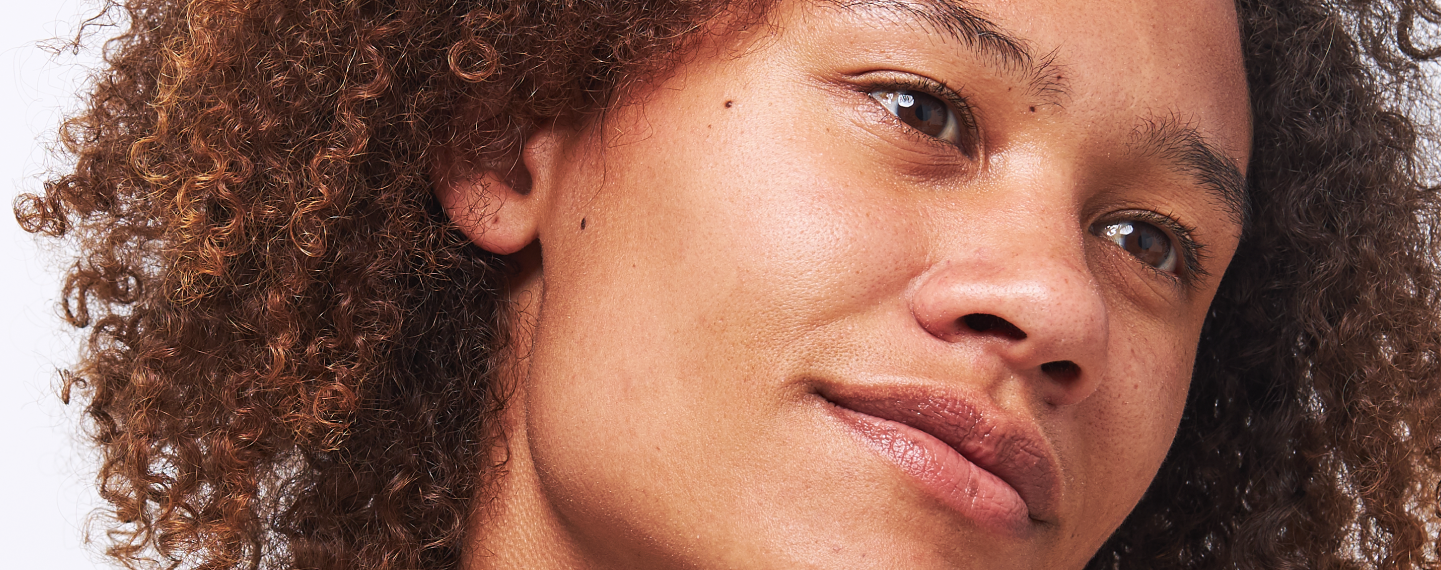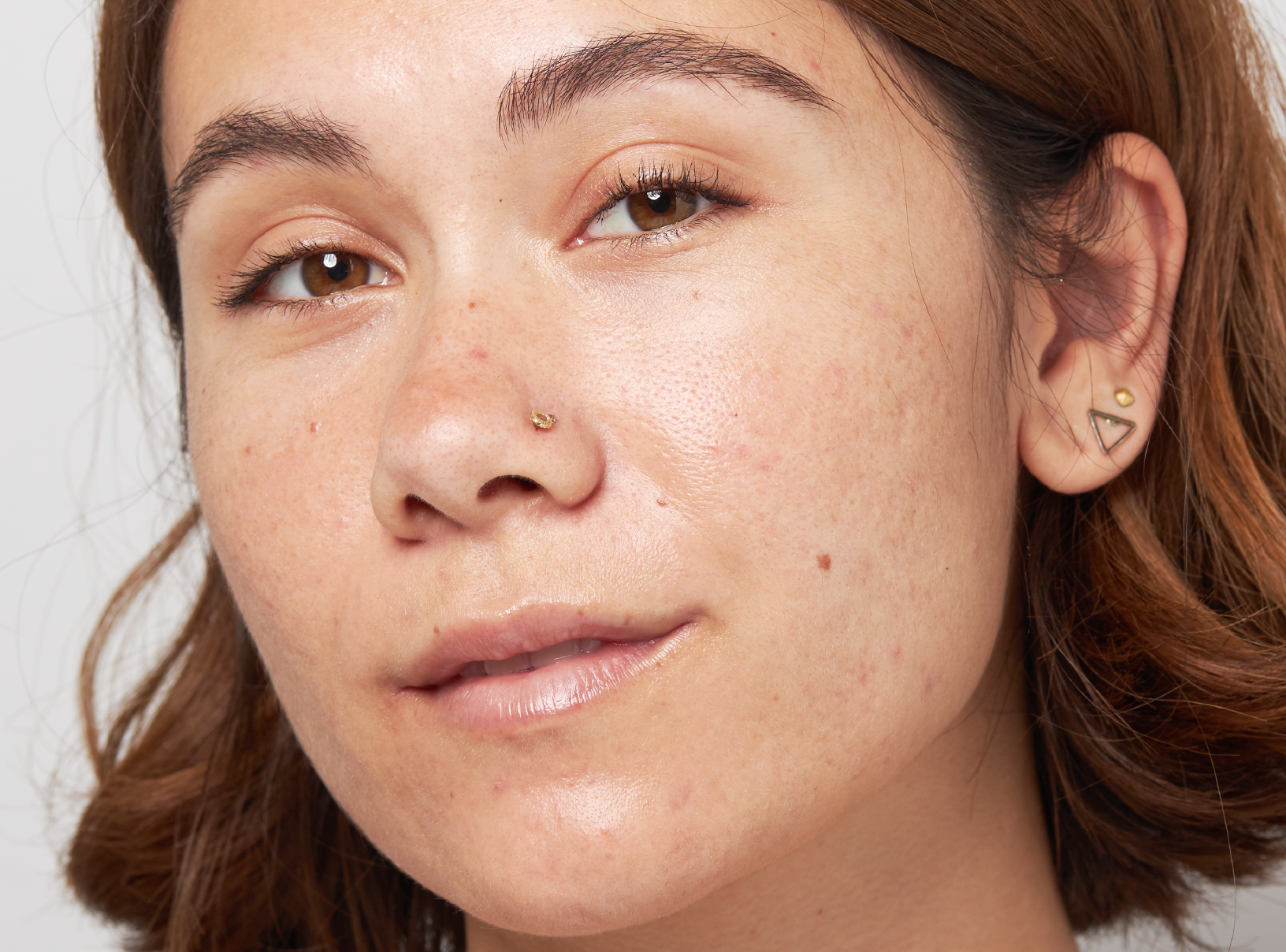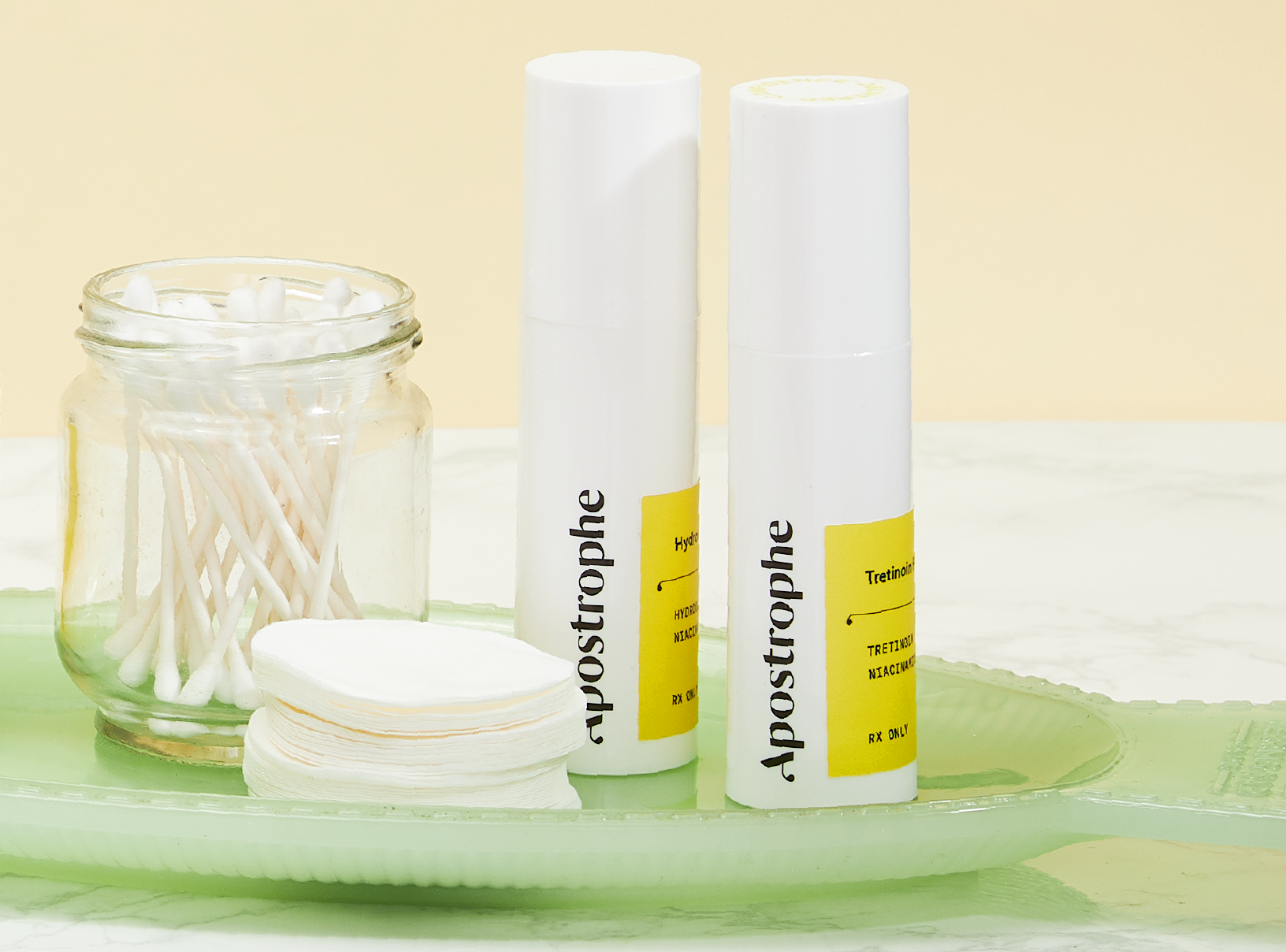Education
How Long Does it Take For Hydroquinone to Work | Apostrophe


SHARE
Education
How Long Does it Take For Hydroquinone to Work | Apostrophe
Medically reviewed by Aimee Paik, MD
Written by Apostrophe Team
Last updated 11/3/2024
Sun spots, hyperpigmentation, and melasma can be frustrating skin conditions to deal with. While many people may worry that uneven skin tone is a permanent problem—especially when caused by damage from UV rays—there are actually a number of ways this skin concern can be treated.
What is the current gold standard for reversing sun damage and reducing the appearance of dark spots? A helpful little compound known as hydroquinone. Hydroquinone is a powerful ingredient found in prescription strength, skin lightening products. By influencing the overproduction of melanin in the skin, hydroquinone can help reduce dark spots and patches on the skin, and even out complexion.
How does this skin care solution work, though? More specifically: how long does it take for hydroquinone to work? Here’s everything you need to know!
What is Hydroquinone?
Before we can discuss the timeline of a treatment plan, let’s first give a brief overview of what hydroquinone actually is. Hydroquinone is a skin lightening agent used to treat the following conditions:
Melasma
Sun damage
Freckles
Post-inflammatory hyperpigmentation
Hydroquinone works by inhibiting an enzyme called tyrosinase. Tyrosinase plays a major role in the body’s melanin production. This basically means that when hydroquinone is applied topically, it sends a signal to the skin to produce less melanin in that area.
What Causes Hyperpigmentation?
Hyperpigmentation can develop for a number of reasons. The most common reason for dark spots is due to photoaging from UV radiation. When the skin is exposed to the sun for too long, the UV rays can stimulate skin cells to produce more melanin.
The bottom line is: more melanin in a specific area results in darker spots or patches. In addition to UV damage, darker skin in certain areas may also be the result of:
Hormonal changes
Genetics
Acne
Whatever the root cause, hydroquinone can be an effective method of treating various types of hyperpigmentation.

CUSTOMIZED HYPERPIGMENTATION TREATMENT
Get customized treatment for your dark spots, melasma, and hyperpigmentation.
How Should Hydroquinone Be Applied?
How to use hydroquinone? Due to its powerful skin-lightening effect, hydroquinone should not be applied to the entire face or large parts of the body. Instead, products that contain hydroquinone should be applied in small doses to specific areas. This is the best way to target hyperpigmentation and properly even out skin tone.
Hydroquinone will typically come in the following forms:
Hydroquinone Cream
Hydroquinone Gel
Hydroquinone Solution
No matter what type of hydroquinone acne scar or skin lightening product you’re using, you’ll want to follow the proper instructions provided by your dermatology provider. It’s important to patch test any new skin care ingredients by applying a small amount to the forearm first. If no irritation occurs, you can proceed and apply the product to the face. Patients should also remember to wash their hands after applying hydroquinone, in order to avoid spreading the product in places where it’s not needed.
How Long Should Hydroquinone Be Used For?
Now that we have a deeper understanding of what hydroquinone does, it’s time to discuss how long it should be used for.
When using hydroquinone, patients should not expect to see drastic results right away. It can take approximately 4-6 weeks of daily (or even twice daily) hydroquinone application before dark spots will begin to fade. After 8-12 weeks, optimal results should appear and overall skin tone will become more even. Typically, dermatologists will prescribe hydroquinone cyclically, on for a few months, off for a few months, then on again.
If results do not begin to appear after 8-12 weeks, a different skin care treatment may be prescribed instead.
Are the Effects of Hydroquinone Permanent?
Not exactly. Maintenance and a proper treatment plan will be necessary in order to keep dark spots from reemerging.
Hydroquinone can, however, result in long-lasting results that keep hyperpigmentation at bay. The trick to making hydroquinone work? The right dosage and administration.
How is Hydroquinone Prescribed?
Unlike other skin care treatments, which may be used for a short period of time or long-term—Hydroquinone is generally administered cyclically.
More specifically, it’s recommended to limit hydroquinone treatments to 3-6 month increments. After this period, your dermatology provider may remove the product from your skin care plan for several months. After that, hydroquinone may be prescribed once again to improve or maintain results.
Why is hydroquinone administered in cycles? Mainly to avoid a rare side effect known as ochronosis.
What is Ochronosis?
Ochronosis is a rare side effect that has been linked to prolonged hydroquinone use. This side effect presents itself through black or blue skin discoloration.
It’s important to note that hydroquinone is perfectly safe to use, and that ochronosis is rare and typically limited to patients who are using high doses of the product with continued sun exposure. That being said, this is still something that dermatologists want to avoid at all costs. Therefore, hydroquinone treatments are limited to a few months at a time for this reason.
During your off periods, a gentler lightening agent, such as azelaic acid, may be used in place of hydroquinone. This technique will help maintain results without risking further discoloration.
How Strong is Hydroquinone?
Hydroquinone comes in a 4% prescription that is commercially available. Higher strengths must be compounded by a compounding pharmacy. The strength of your skin product will determine how often it should be applied and for how long. If irritation occurs, your dermatology provider may recommend pulling back and limiting treatment to 3 days a week, rather than daily application.
Side Effects of Hydroquinone
Like any other skin care ingredient, hydroquinone can come with a handful of side effects for certain people. As previously mentioned, rare cases of ochronosis have been tied to prolonged use of hydroquinone. Some less severe (but more common) side effects of hydroquinone treatment may also include:
Increased sun sensitivity
Skin irritation
Allergic contact dermatitis
Stinging
Most of these side effects tend to appear early on when undergoing hydroquinone treatment. Once the skin gets acclimated to this ingredient, irritation will usually subside.
Sun sensitivity will remain for the entirety of the treatment, however. So it’s important to take extra precaution in terms of UV protection when using hydroquinone. Moreover, preventing UV exposure is very important for the treatment of hyperpigmentation. Try to avoid direct sun exposure with wide-brimmed hats and shade, and always remember to wear an SPF throughout the day.
Ingredients to Avoid When Using Hydroquinone
In order to decrease the risk of side effects, patients using hydroquinone should also limit their use of other skin care products. Below are some ingredients to look out for when undergoing hydroquinone treatment:
Benzoyl and Hydrogen Peroxide
Patients using hydroquinone should avoid any skin care product that contains benzoyl peroxide.
Benzoyl peroxide is an antimicrobial ingredient used to treat mild-to-moderate acne. While benzoyl peroxide can be beneficial when applied on its own, combining this ingredient with hydroquinone can lead to adverse side effects.
Specifically, the combination of benzoyl peroxide and hydroquinone may cause a temporary staining of the skin. In fact, any type of peroxide (including hydrogen peroxide) should not be used in conjunction with hydroquinone.
Resorcinol
Resorcinol is another skin care ingredient that should not be combined with hydroquinone, either. Resorcinol is a topical ingredient used to treat conditions such as:
Eczema
Psoriasis
Acne
Warts
Calluses
Corns
Hyperpigmentation
When used alongside hydroquinone, resorcinol can increase the risk of developing ochronosis.
Harsh Exfoliants
Finally, we have the broad category of harsh exfoliants that may not mix well with hydroquinone. While exfoliants like AHAs and salicylic acid won’t necessarily cause a chemical reaction when combined with hydroquinone, they can intensify the irritation that may occur early on.
It’s recommended that patients steer clear of any harsh exfoliants and acids while their skin gets used to the hydroquinone treatment. After a period of time, you may be able to slowly work these stronger ingredients back into your skin care plan.
Don’t Leave Hydroquinone Exposed to Air
It’s important to note that hydroquinone products should not be left open or exposed to air for long periods of time. This is because prolonged exposure to air will cause the medication to oxidize and make it ineffective.
You should store products that contain hydroquinone in a cool, dark place with limited vulnerability to heat or air. These will create the ideal conditions for an effective hydroquinone product.

HYPERPIGMENTATION TREATMENT
Target dark spots and hyperpigmentation with customized prescription treatment.
Find High Quality Skin Care Solutions with Apostrophe
Although hydroquinone was once available over the counter in low concentrations, this powerful ingredient is now a prescription-only treatment. Fortunately, Apostrophe makes it easy to get high-quality, prescription skin care from the comfort of home.
Here’s how it works: through Apostrophe, patients will pay $20 for a virtual derm consultation. From there, an expert derm team will craft a personalized treatment plan to meet your skin’s unique needs.
Once you receive your curated plan, you’ll be able to purchase your prescription-strength products directly from the Apostrophe website. Users can get a three month supply of topical treatments starting at only $25 per month.
Give your skin the custom skin care products it deserves, and get high quality solutions with the click of a button. Start your journey to even skin tone and maximum confidence, with Apostrophe!
Sources:
Science Direct. Melanin Transfer: The Keratinocytes Are More than Gluttons.
https://www.sciencedirect.com/science/article/pii/S0022202X15367464
Promo Cell. Keratinocytes. https://promocell.com/cell-culture-basics/keratinocytes/
US National Library of Medicine. Hydroquinone.
https://www.ncbi.nlm.nih.gov/books/NBK539693/
American Osteopathic College of Dermatology. Hydroquinone.
https://www.aocd.org/page/Hydroquinone
FDA. Rulemaking History for OTC Skin Bleaching Drug Products.
https://www.fda.gov/drugs/status-otc-rulemakings/rulemaking-history-otc-skin-bleaching-drug-products
American Academy of Dermatology. Dermatologist shines light on natural ingredients used in new topical treatments for hyperpigmentation.
US National Library of Medicine. A Comparative Study of the Efficacy of 4% Hydroquinone vs 0.75% Kojic Acid Cream in the Treatment of Facial Melasma.
https://www.ncbi.nlm.nih.gov/pmc/articles/PMC3657227/
Medical Journals. Hydroquinone Therapy for Post-inflammatory Hyperpigmentation Secondary to Acne: Not Just Prescribable by Dermatologists.
https://www.medicaljournals.se/acta/content/html/10.2340/00015555-1225
Shop this post

Hydroquinone
Like what you just read? Sign up for our email list to get the scoop on skincare science delivered straight to your inbox.

Deep Dives
A dermatologist shares his thoughts on the recent studies about benzoyl peroxide and benzene.
Read More
Education
What is milia?
What is milia? Today, we’re jumping into one type of bump that you may have heard about most commonly in infants — milia.
Read More
Education
Best moisturizer for acne-prone skin
If you have combination acne-prone skin, figuring out which moisturizer is best for your skin might be tough. In this guide, we break down the best moisturizer for combination, acne-prone skin.
Read More